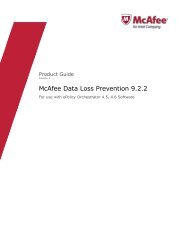Host Intrusion Prevention 7.0.0 for ePO 4.0 Product Guide - McAfee
Host Intrusion Prevention 7.0.0 for ePO 4.0 Product Guide - McAfee
Host Intrusion Prevention 7.0.0 for ePO 4.0 Product Guide - McAfee
You also want an ePaper? Increase the reach of your titles
YUMPU automatically turns print PDFs into web optimized ePapers that Google loves.
Configuring Firewall Policies<br />
Overview of Firewall policies<br />
computer’s connection state. Access to the application level commands provides error-free<br />
inspection and securing of the FTP protocol.<br />
State table<br />
A stateful firewall includes a state table that dynamically stores in<strong>for</strong>mation about active<br />
connections created by allow rules. Each entry in the table defines a connection based on:<br />
• Protocol — The predefined way one service talks with another; includes TCP, UDP and<br />
ICMP protocols.<br />
• Local and remote computer IP addresses — Each computer is assigned a unique IP<br />
address. IPv4, the current standard <strong>for</strong> IP addresses permits addresses 32 bits long, whereas<br />
IPv6, a newer standard, permits addresses 128 bits long. IPv6 is already supported by some<br />
operating systems, such as Windows Vista and several Linux distributions. <strong>Host</strong> <strong>Intrusion</strong><br />
<strong>Prevention</strong>s supports both standards.<br />
• Local and remote computer port numbers — A computer sends and receives services<br />
using numbered ports. For example, HTTP service typically is available on port 80, and FTP<br />
services on port 21. Port numbers range from 0 to 65535.<br />
• Process ID (PID) — A unique identifier <strong>for</strong> the process associated with a connection’s<br />
traffic.<br />
• Timestamp — The time of the last incoming or outgoing packet associated with the<br />
connection.<br />
• Timeout: — The time limit (in seconds), set with the Firewall Options policy, after which<br />
the entry is removed from the table if no packet matching the connection is received. The<br />
timeout <strong>for</strong> TCP connections is en<strong>for</strong>ced only when the connection is not established.<br />
• Direction — The direction (incoming or outgoing) of the traffic that triggered the entry.<br />
After a connection is established, bidirectional traffic is allowed even with unidirectional<br />
rules, provided the entry matches the connection’s parameters in the state table.<br />
State table functionality<br />
Note the following about the state table:<br />
• If firewall rule sets change, all active connections are checked against the new rule set. If<br />
no matching rule is found, the connection entry is discarded from the state table.<br />
• If an adapter obtains a new IP address, the firewall recognizes the new IP configuration and<br />
drops all entries in the state table with an invalid local IP address.<br />
• When the process ends all entries in the state table associated with a process are deleted.<br />
How firewall rules work<br />
Firewall rules determine how to handle network traffic. Each rule provides a set of conditions<br />
that traffic has to meet and has an action associated with it: allow or block traffic. When <strong>Host</strong><br />
<strong>Intrusion</strong> <strong>Prevention</strong> finds traffic that matches a rule’s conditions, it per<strong>for</strong>ms the associated<br />
action.<br />
<strong>Host</strong> <strong>Intrusion</strong> <strong>Prevention</strong> uses precedence to apply rules: the rule at the top of the firewall<br />
rules list is applied first.<br />
If the traffic meets this rule’s conditions, <strong>Host</strong> <strong>Intrusion</strong> <strong>Prevention</strong> allows or blocks the traffic.<br />
It does not try to apply any other rules in the list.<br />
<strong>McAfee</strong> <strong>Host</strong> <strong>Intrusion</strong> <strong>Prevention</strong> 7.0 <strong>Product</strong> <strong>Guide</strong> <strong>for</strong> use with ePolicy Orchestrator <strong>4.0</strong><br />
47

















